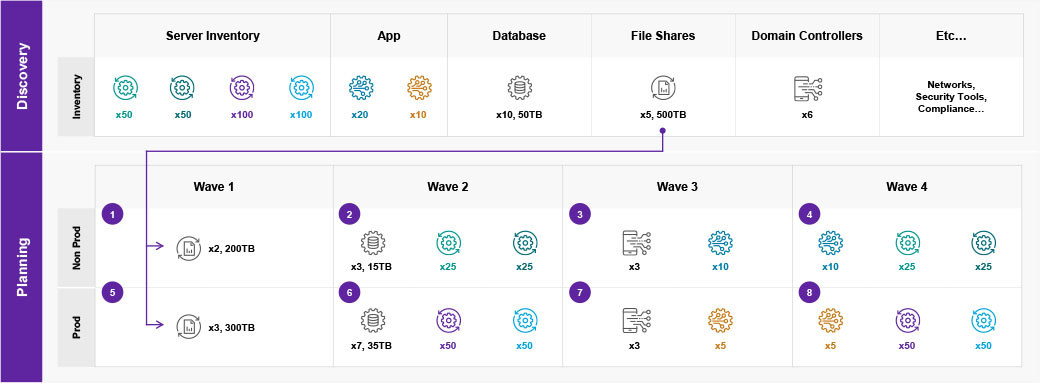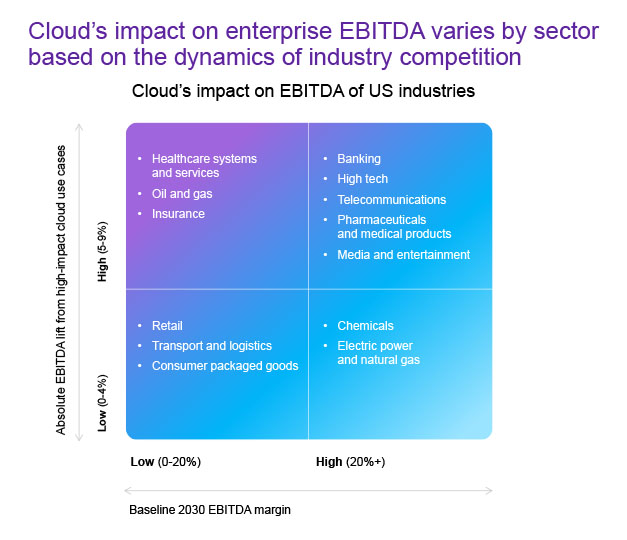In brief
- Data centers require substantial investment into maintenance and staffing while failing to deliver the scalability, agility, and capacity that competing in a digital-first world requires. In contrast, the cloud offers unparalleled capacity elasticity, automated scalability, and cost-efficiency that on-premises data centers can’t
- Data center exits have four phases: discovery and assessment, planning, migration, and wrapping up. Migration should happen in iterations (waves), from lower-risk, more siloed-off workloads to more complex ones
- To make your data center exit a success, minimize exit costs with buy-outs and dedicated programs, manage post-exit organizational and other changes, prepare workloads for migration, and leverage the opportunity to modernize your systems
Ill-prepared moves are synonymous with stress and chaos.
Exiting a data center without a proper strategy is, at best, disjointed. At worst, workloads spread across several locations while migration stalls, timelines slip and budgets stretch. The organization suffers perpetual disruption, causing penalties and sunk costs to threaten the bottom line.
Here’s how to devise a data center exit strategy to avoid the chaos and overblown costs of a hasty move.
Data center: What’s in the name?
A data center is home to hundreds or thousands of servers hosting enterprise data and applications, along with storage and networking equipment required to maintain connectivity and performance. Data centers require strict environmental control, continuous power supply, and tight security with restricted physical access.
An on-premises data center can reside in a separate building, a dedicated space in an office building, or group of buildings. Smaller organizations can also host their data centers in colocation facilities where they share the floor with other organizations to optimize costs and facilitate upkeep.
Running an on-premises data center is a challenge
Running a traditional data center is a massive undertaking that poses substantial challenges:
- Scaling it up can take weeks or months, especially if the existing space can’t accommodate new hardware
- Scaling down is also slow, resulting in excess capacity sitting idly
- Adapting security practices requires a hands-on approach (as opposed to cloud services where the provider takes care of most security updates)
- Data center hardware slowly deteriorates and becomes outdated over time, requiring capital expenditure to replace it
- The building itself requires maintenance as well, from the cooling systems to the physical access controls
- Legacy data centers are difficult to modernize and align with the latest technologies; some technologies can be run only in the cloud (e.g., GenAI, IoT)
- Data centers require round-the-clock staff to handle potential failures, as well as specialists for maintaining and upgrading the hardware and software
Is it time for a data center exit?
Well-timed data center exits usually take place when an organization reaches the end of its lease, faces hardware end-of-life, needs to consolidate data centers, or decides to migrate workloads to the cloud environment.
End of lease
Is the facility lease on the horizon? Then, it’s a perfect opportunity to set your data center exit strategy in motion without risking sunk costs or penalties for quitting a lease ahead of time. Remember that a data center exit is a lengthy process, taking a year or more in many cases.
Consolidation
You may choose to consolidate data center operations in a single facility if:
- Your current capacity substantially exceeds your needs, with resources sitting idly
- A merger or acquisition deal resulted in excess data center capacity
However, consolidating multiple data centers into a single facility could prove resource-intensive as you might need to secure new equipment, enter a new lease and so on. Instead, you can migrate your workloads into the cloud one after another, decommissioning data centers altogether.
Hardware end-of-life
Cooling, power, and security systems typically have a lifespan of 10 years or so. Meanwhile, individual components (routers, servers, etc.) need to be replaced every 3 to 5 years.
If your data center’s hardware has become obsolete or too outdated to keep up with modern technology, it’s another opportunity to consider data center migration.
Cloud migration
If you plan to migrate your data and applications to the cloud as part of a larger cloud adoption strategy, there’s a good chance you won’t need as many on-premises data centers anymore. Modernizing legacy systems or replacing them with Software as-a-Service (SaaS) solutions may also prompt a data center exit.
Four phases of a successful data center exit
As with most projects, a data center exit happens in phases. In this case: Discovery, planning, execution, and wrap-up. However, designing and executing a data center exit comes with its own peculiarities, like penalties for contact termination and equipment disposal.
1. Discovery and assessment
Before you can shut down your legacy data center, you need to migrate workloads. And before that, you need to know what has to be migrated.
To take inventory as part of a data center exit strategy, document:
- Existing hardware
- Software applications
- Storage layers (file shares, databases), data formats, backups
- Operating systems
- Network configurations
- Operation models (e.g., virtualization, escalation management)
Consider business factors, such as:
- Ongoing leases and potential penalties
- Depreciation schedules
- Service contracts
- Licensing and compliance requirements
Once you have a list of resources that comprise the current data center footprint:
- Map out dependencies with third-party applications, domain controllers, etc.
- Classify resources based on the operating environment (production/non-production)
- Assess the business impact of applications to be migrated
- Pinpoint governance and business continuity requirements
- Assess the resources’ readiness for migration

To facilitate discovery, consider using automated discovery tools and adopting an iterative approach to discovery and assessment.
2. Planning
Moving everything at once is a recipe for disaster. That’s why you should conduct migration in waves, from lower- to higher-risk workloads.
It’s also best to start with simpler resources (e.g., file shares, databases) and finish with more complex ones (e.g., applications) while taking dependencies into account. As for applications, start with the most siloed and move to those with more dependencies.

During this phase, you will also need to:
- Design the new infrastructure architecture and landing zones
- Determine the timeline and deliverables for each migration wave
- Analyze the financial implications of the migration and set a budget
- Secure buy-in across key stakeholders in the organization
- Decide what you will do with the data center assets once they’re no longer needed
Besides mapping migration waves and target destinations, consider any organizational and operational changes that may be necessary as part of your data center exit strategy. For example, you will probably need to lay off staff or hire new specialists. You might also decide to implement DevOps and CI/CD.
3. Migration
Now, it’s time to execute your data center exit strategy. If you’ve done your planning correctly, your team will start with the workloads that are the easiest to move and finish with the most complex ones.
Each migration wave consists of three stages: Review (mapping configuration), deployment, and testing.
Throughout migration:
- Strive to automate as many processes as possible
- Log and monitor processes themselves and migrated workloads
- Create backups before migrating workloads
As the data center exit strategy can take months to execute, ensure your migrated workloads can operate in conjunction with those that remain in the data center. Otherwise, you risk unplanned downtime and business disruptions.
4. Wrap-up
Once all of your workloads are migrated and tested on the new infrastructure, you can shut down your corporate data center. Decommission or pack and move the equipment, vacate the premises, and turn off the lights.
If you migrate workloads to the cloud, this phase also involves regularly reviewing and optimizing resource consumption. To that end, make sure to set up comprehensive monitoring and logging to have a full view of resource consumption.
Pay close attention to data center exit costs
When planning your data center exit, factor in:
- Penalties for early contract termination (lease, service vendors)
- Hardware disposal costs to decommission equipment according to e-waste and other regulations
- Potential double-bubble costs (workloads spread between the target destination and existing data center can result in double costs)
- Possible legacy modernization costs for preparing your applications for the cloud
To minimize costs:
- Identify which CapEx costs could be recouped (for instance, the equipment still performing well can be sold off)
- Plan ahead to avoid disruptions to your business operations during the migration
- Ensure you have the right staff with an appropriate skill set to handle the exit. Consider hiring a data center exit partner
Consider monetizing your data center exit
You don’t have to accept the expenses of a data center exit as a necessary evil. Cloud vendors, original equipment manufacturers, and data center exit partners offer programs for facilitating such transitions.
A data center exit program can fund your migration by buying out data center equipment, facility leases, and other contracts that would otherwise lead to penalties for early termination. Some programs also offer capital upfront to fund the exit.
Why migrate to the cloud?
Gartner expects three-quarters of organizations to adopt digital transformation strategies predicated on cloud services.
So, chances are high that you’re planning to transfer some or all workloads to the cloud during your data center exit. Doing so will allow you to:
- Boost business agility and improve time-to-market with near-instant scalability, capacity elasticity, and transparent refresh management
- Shift from CapEx to OpEx costs, reduce the TCO, and benefit from an EBITDA lift
- Improve cost control with greater cloud computing resource consumption visibility
- Adopt the latest modern technologies (AI, advanced analytics, IoT, etc.)
- Ensure high uptime, security, and compliance without significant investment as the vendor takes those on

Questions to consider before moving to the cloud
Cloud adoption strategy is a separate topic with plenty of best practices, tips, and pitfalls to avoid. Still, if you’re planning to move your workloads to the cloud during the data center exit, you must consider the following:
- Should you migrate all workloads as-is? Chances are, you can remove duplicate data or replace multiple applications that perform identical or near-identical functions with a single application
- Are your workloads ready for the cloud environment? You may need to modernize your applications before running them in the cloud
- What is the right migration approach for you? Some workloads can be lifted and shifted (rehosted), while others may need refactoring, reengineering, replacing, or rearchitecting to prepare them for the cloud infrastructure
- Which type of cloud suits you best? Some organizations can move their workloads completely to the public cloud. Others will find the multicloud or hybrid cloud model more suitable
- Which type of cloud suits you best? Some organizations can move their workloads completely to the public cloud. Others will find the multicloud or hybrid cloud model more suitable
- What is your target cloud operating model? It defines how you’ll operate in the cloud, from the talent you need to governance, risk, and compliance processes

A word on choosing the right cloud service provider
When shopping for cloud services, analyze and compare:
- Provider’s certifications and standards and whether they meet your security and compliance requirements
- Integration with existing services and available orchestration tools
- Data governance, management, and security measures
- Risk of lock-in and service dependencies
- Available analytics and reporting functionality for keeping track of resource consumption and performance
- Guaranteed uptime, service capacity, response time, and elasticity
- Pricing model and costs, including initial data transfer costs
How to set up your data center exit for success
The most effective data center exit strategies typically follow these nine best practices:
- Prepare a solid business case to secure the buy-in and justify the exit as a strategic undertaking
- Invest enough time into doing the inventory, planning the exit, and designing the target destination
- Treat the exit as an opportunity to modernize applications and components
- Follow through on any organizational, staff, and process changes imposed by the exit
- Start migrating the simplest, lowest-risk workloads to catch potential issues early on
- Group workloads based on their dependencies to minimize disruptions
- Don’t underestimate the complexity of a data center exit
- Pay close attention to governance, data security, and compliance during the migration
- Routinely create backups with restoration and failover options
Let’s talk
Preparing for a data center exit as part of your digital transformation journey? Contact us to discuss how DXC Luxoft’s partner network and migration and cloud adoption expertise can help you make your exit smooth, predictable, and cost-efficient.





